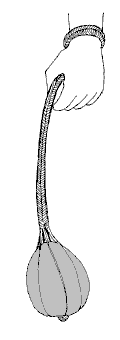
Human Hair as Fibre for Fabric
If humans made necklaces and armlets using pebbles or bone, it has to be asked what they used to string them together. One answer is that they used their own hair as the basic fibre to spin, braid, or weave. Assuming that hair grows at 0.5 mm per day, and that there are 100,000 hairs on a head, then daily production is 50 metres per day. Furthermore, this fibre is produced on the immediately accessible crown of one's own head, not in some remote field or grove.
 Humans could use their own hair for a variety of purposes.
It could be braided into fine twine or thick rope. It could be woven
into sheets or felt mats. It could be the matrix which bound
together stones, pebbles, pieces of wood. This could have
served to make the armlets and anklets needed for defence.
It could also be used to make pouches and bags.
Humans could use their own hair for a variety of purposes.
It could be braided into fine twine or thick rope. It could be woven
into sheets or felt mats. It could be the matrix which bound
together stones, pebbles, pieces of wood. This could have
served to make the armlets and anklets needed for defence.
It could also be used to make pouches and bags.
Stones, twigs or bone need not have been pierced to allow a passage for string, but simply notched to allow the twine of hair to grip from outside. Cutting notches in stones would have been much easier than laboriously boring holes through them. Since the twine could be very fine - a few hairs - or coarse rope, almost any size of stone could be bound together.
 Simple weapons could be constructed using the same principle.
Using a single heavy stone, its sides deeply notched to take
thick twine, and a length of rope made up of braided hair, a
heavy cosh could be made which could deliver a powerful
blow. These might have been used to drive off predators which
were attacking an individual human.
Simple weapons could be constructed using the same principle.
Using a single heavy stone, its sides deeply notched to take
thick twine, and a length of rope made up of braided hair, a
heavy cosh could be made which could deliver a powerful
blow. These might have been used to drive off predators which
were attacking an individual human.
Bags or pouches, made of woven hair, could have been waterproofed using natural latex or tar. This would have enabled humans to carry small waterbags, long before they could use animal bladders or skins for the same purpose.
The resources of hair available in a human community could include those of previous generations, if hair flexibility could be retained for long periods using natural oils or resins. Thus a human community would probably have a considerable store of hair products, which could be re-used.
Humans may have been expert weavers long before they began using stone tools. Little or no evidence of this would appear in the fossil record. The ropes, garments, and bags they made would have ultimately degraded, leaving no fossil evidence except a few dispersed notched stones and bones. Skill in weaving human hair would have formed the basis for subsequent weaving of cotton and wool.
Use of human hair in thise way would have resulted in artificial selection for abundant, long hair in humans. Those humans with more abundant hair than others would be prized, and given high status, because the hair that an individual produced was as valuable as the work they did. Different kinds of hair would have been used for different purposes. The fine hair would have been used for small detailed work and garment lining, and robust thick hair for ropes and bags.
Apart from its use in textiles, there may be a quite different explanation for abundant hair on human heads.
